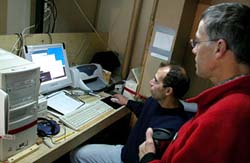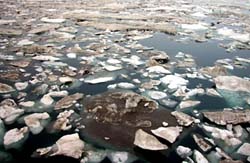|
|
 |
Daily Update
Calendar
Dispatch 09 - July 23, 2002
By C.A. Linder
Weather conditions: overcast skies, calm winds and seas, air temperature 36° F.
Odobenus rosmarus
I’ll start out this dispatch with a question I received via the arcticedge@whoi.edu email address:
Q: I am greatly enjoying the Daily Updates and photographs. Thanks for providing such a wonderful picture of the Arctic. My question is...have the crewmembers seen any other polar wildlife besides polar bears? -Amy
A: Up until today, I would say - very little. Only hours from leaving Dutch Harbor we encountered a pod of humpback whales, and before we entered the pack ice a few walruses swam by the ship. We also spotted a small number of seabirds. Today, however, has been amazing! We have been transiting on the fringe of the pack ice, known as the marginal ice zone, on the way to Barrow Canyon, and have seen literally hundreds of walruses and several polar bears and seals. Although walruses (scientific name Odobenus rosmarus) spend their lives at sea, they use chunks of ice as “haulouts,” and congregate in large groups for warmth and protection. This afternoon we came across several large herds of walruses hauled out on the ice, and the sight was unbelievable! Although we steered away from them so as to not disturb them, they still were spooked enough to vacate their ice floes. Huge splashes went up as their 1 ton bodies hit the water, and they grunted and barked angrily at being disturbed. On the adjacent ice floe we saw a polar bear - there was no doubt what he was doing there!
 |
 |
|
Principal Investigators Bob Pickart (left, seated) and Tom Weingartner discuss the data we have just collected. |
|
Click to enlarge |
 |
|
Sediment and algae give the ice near Barrow Canyon a “dirty” look. |
|
Click to enlarge |
It was another day of planning and preliminary data analysis for the science crew (those who weren’t watching for walruses!) It is extremely difficult to predict how fast the ship will get from point A to point B due to the ever-changing ice conditions. We can easily be steaming up to 14 knots in open water with good visibility, but fog and ice can quickly cut our speed to as slow as 4 knots. This means that we have to be flexible. The moorings must all be deployed on this cruise, so if sacrifices need to be made we will be cutting some CTD stations. It’s very tough for the scientists who have spent so much time planning this cruise, but here in the Arctic, the ice has the final word.
Q: I’ve really been enjoying the website. It’s very informative and interesting and explains things well for the non-expert.
I was wondering about the “Specter of Brocken” mentioned a few days back. What is the origin of this weird effect and how did it get this name? Thanks! Cecile
A: Excellent question! The name of this unique optical effect comes from Brocken, a mountain peak in the Harz Mountains of Saxony, Germany. Mountaineers would occasionally see their giant-sized shadows cast onto the clouds below, encircled by an “anticorona” or halo of light. The water particles in the fog cause this halo by diffracting the sunlight. You can observe this effect anytime you are at an altitude higher than a cloud or fog layer with the sun shining directly behind you. In fact, science party member Dan Torres has an amazing video of the flight from Dutch Harbor to the Polar Star where you can see a halo around the helicopter’s shadow!
Send your questions about Arctic oceanography and shipboard life to arcticedge@whoi.edu
I’ll do my best to find the answers!
 Previous Dispatch
Next Dispatch Previous Dispatch
Next Dispatch

Back to Calendar
|
|




